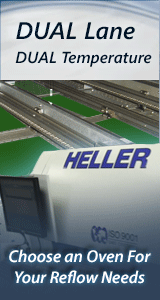I reposted this in case the source became unsupported. [http://www.qsl.net/wb6tpu/si-list4/1316.html ]
"[SI-LIST] : Information on FR-4 and other PCB dielectric materials From: "jrbarnes@lexmark.com Date: Wed Apr 12 2000 - 06:24:34 PDT
TIA, For the last nine months I have been researching the ampacity (safe current-carrying capacity) of printed circuit board (PCB) traces and planes as a side project to my "normal" work. The most complete, up-to-date source of information on that I have found on PCB dielectrics is IPC-4101, Specification for Base Materials for Rigid and Multilayer Printed Boards. You can order it through the IPC Bookstore at http://www.ipc.org/
Some books with a lot of information on PCB dielectrics are: * Handbook of Electronic Packaging (Charles A. Harper, McGraw-Hill, 1969) * Handbook of Wiring, Cabling, and Interconnecting for Electronics (Charles A. Harper, McGraw-Hill, 1972) * Printed Circuits Handbook 3rd ed (Clyde F. Coombs, Jr., McGraw-Hill, 1988) * Multilayer and Flexible Circuits (Clyde F. Coombs, Jr., McGraw-Hill, 1990)
The Dynacircuits Material Specifications for Printed Circuit Boards Sliderule (dated 1985) has the following information on common PCB dielectrics: * Phenolic paper XXXP GE 11571 4.1 permittivity 740V/mil 30C Tg max 125C operating * Phenolic paper FR-2 GE 11800 4.2 permittivity 700V/mil 60C Tg max 105C operating * Epoxy CEM-1 GE 65M62 4.2 permittivity 550V/mil 70C Tg max 130C operating * Epoxy CEM-3 GE 65M78 4.0 permittivity 550V/mil 120C Tg max 130C operating * Epoxy FR-3 GE 65M41 4.3 permittivity 700V/mil 60C Tg max 105C operating * Epoxy FR-4 GE 65M38 4.9 permittivity 500V/mil 120C Tg max 130C operating * Polyester glass FR-6 Cincinnati Milacron Cimclad 4.2 permittivity 500V/mil 65C Tg max 130C operating * Polyester glass CRM-5 Cincinnati Milacron Milclad 4.2 permittivity 500V/mil 65C Tg max 130C operating
If you are on a hurry, MIL-S-13949H and its slash sheets probably have the information you are looking for. Go to http://astimage.daps.dla.mil/quicksearch/ and search for document ID = MIL-S-13949. You will need to relate the material designations to the dielectrics you are interested in as follows-- laminate designation xy or xyz where: * x = reinforment material: - A = woven aramid - B = nonwoven aramid - C = nonwoven polyester - G = woven E-glass - N = nonwoven E-glass - Q = woven quartz - S = woven S-2 glass * y = resin: - B = epoxy, non-flame resistant, hot strength retention - C = cyanate ester, flame retardant - F = epoxy, flame resistant - H = epoxy, flame resistant, hot strength retention - I = polyimide, high temperature - M = epoxy, flame resistant - P = polytetraflouroethylene, flame resistant - R = polytetraflouroethylene, flame resistant, for microwave applications - T = polytetraflouroethylene, flame resistant - X = polytetraflouroethylene, flame resistant, for microwave applications - Y = polytetraflouroethylene, flame resistant, for microwave applications * z = special consideration: - G = natural color F resin with 150-200C glass transition temperature - J = natural color I resin with 200-250C glass transition temperature - K = natural color F resin with 110-150C glass transition temperature - L = natural color I resin with > 250C flass transition temperature - M = coloring agent or opacifier added to F resin with 110-150C glass transition temperature - N = natural color of resin - P = coloring agent or opacifier added to resin - T = natural color F resin blended with nonepoxy resins for high temperature integrity, with 170-220C glass transition temperature
From the Handbook of Electronic Packaging (Charles A. Harper, McGraw-Hill, 1969) * NEMA grade MIL spec Maximum service temperature * XX PBG 250F paper & >=45% by weight phenolic * XXP PGB 250C paper & >=45% by weight phenolic * XXX PBE paper & >=58% by weight phenolic * XXXP PBE-P paper & >=58% by weight phenolic * XXXPC PBE-P 250F paper & >=58% by weight phenolic * FR-2 PBE-P paper & >=58% by weight phenolic * FR-3 PEE paper & epoxy * FR-4 GEE glass & epoxy * FR-5 GEB glass & epoxy * G-2 glass & phenolic * N-1 NPG 165F * G-5 GMG 300F glass & melamine * G-7 GSG 350F glass & silicone * G-9 GME glass & melamine * G-10 GEE 250F glass & epoxy * G-11 GEB 300F glass & epoxy
John Barnes Advisory Engineer Lexmark International"
reply »
![]() I reposted this in case the source became unsupported. [ ...
- Jul 18, 2001
by
davef
I reposted this in case the source became unsupported. [ ...
- Jul 18, 2001
by
davef
![]()
![]()
![]() I didn't wade thru all of the info you presented above, but ...
- Jul 18, 2001
by
genny
I didn't wade thru all of the info you presented above, but ...
- Jul 18, 2001
by
genny
![]()
![]()
![]() Two more recent books are Electronic Packagind and Interconn...
- Jul 18, 2001
by
Two more recent books are Electronic Packagind and Interconn...
- Jul 18, 2001
by






